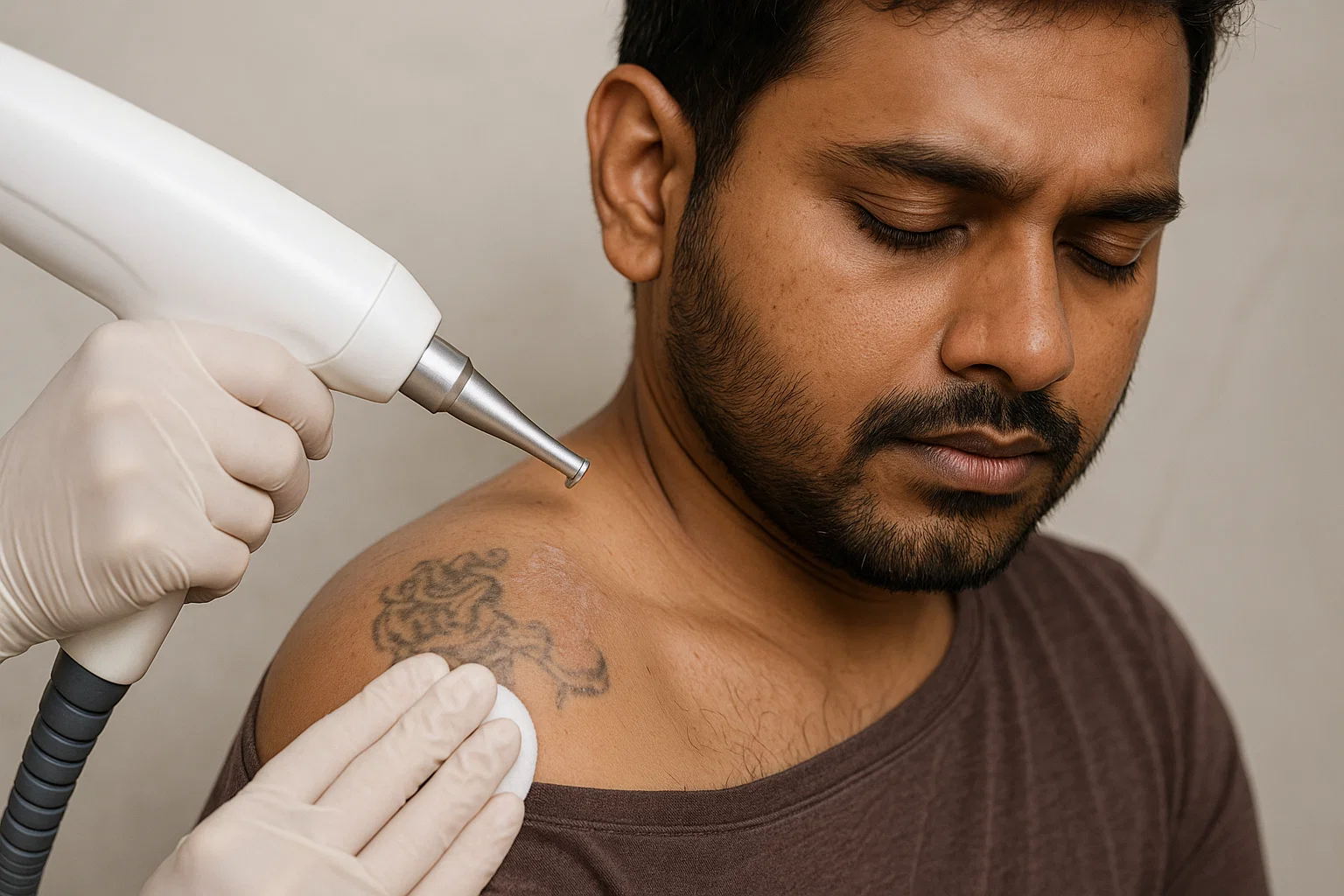Does Tattoo Removal Leave a Scar?

Written by Clear Skin Content Team | Medically Reviewed by Dr. Dhanraj Chavan on October 20, 2025

Thinking about removing your tattoo but worried about scars? With today’s advanced laser technology, tattoo removal can be done safely and effectively with minimal risk of marks or skin damage.
Table Of Content
- Different Ways to Remove a Tattoo
- What Factors Can Cause a Scar?
- How Aftercare Helps Prevent Scars
- Getting the Best Possible Results
- FAQ
- Conclusion
Different Ways to Remove a Tattoo
There are several ways to remove a tattoo, but they are not all equal when it comes to the risk of scarring.
Laser Tattoo Removal
This is the most common and effective method today. Lasers, like the Q-Switch ND:YAG or newer Pico lasers, send powerful beams of light into the skin. This light shatters the tattoo ink into tiny particles. Your body’s immune system then cleans up these small particles over several weeks. Because this method targets the ink specifically, it is much less likely to harm the surrounding skin when done correctly.
Other Methods
Older methods are much riskier. Dermabrasion involves sanding down the skin’s top layers to remove the ink. Surgical excision means cutting the tattooed skin out completely and stitching the remaining skin together. These methods are invasive and carry a much higher risk of leaving a permanent scar. Chemical peels, which use acid to remove skin layers, can also be unpredictable and damaging.
For these reasons, laser removal is the gold standard for safety and effectiveness.
What Factors Can Cause a Scar?
Whether or not you get a scar depends on a few important things. It’s not just about the removal method itself.
Your Skin
Everyone’s skin is different. Some people are more prone to scarring than others. If you have a history of developing keloid or hypertrophic scars (thick, raised scars), your risk is higher. Your skin type and colour can also play a role in how your skin heals.
The Tattoo Itself
The tattoo’s characteristics matter. Deeper tattoos with dense, dark ink are harder to remove and may require more sessions. This increases the chance of skin irritation. The tattoo’s size and location also affect the process. Areas with thinner skin can be more sensitive.
The Person Performing the Removal
The skill of the practitioner is one of the most critical factors. An experienced professional knows how to use the laser correctly for your skin type and tattoo. Using the wrong settings or outdated technology can damage the skin and lead to skin blemishes or scars. A trained expert will ensure the treatment is both safe and effective.
How Aftercare Helps Prevent Scars?
What you do after your laser session is just as important as the treatment itself. Proper aftercare helps your skin heal correctly and greatly reduces the risk of scarring.
Your practitioner will give you specific instructions to follow. This usually includes keeping the area clean, applying a healing ointment, and protecting it from the sun. Sun exposure can damage the healing skin and cause pigmentation issues, which can look like a scar.
It is also vital not to pick at any scabs or blisters that may form. This is a natural part of the healing process. Picking at them can lead to infection and scarring. Following the aftercare plan carefully is the best way to ensure your skin recovers smoothly.
Getting the Best Possible Results
The key takeaway is that while scarring is possible, it is not common with modern tattoo removal when performed correctly. Choosing a qualified professional is the most important step you can take to minimise your risk.
A good practitioner will assess your skin and tattoo before starting treatment. They will explain the process, manage your expectations, and create a personalised plan. For example, a reputable centre like the Clear Skin Clinic Pune will use advanced technology and have trained staff to ensure your safety and comfort.
By taking the time to find the right provider and committing to proper aftercare, you can achieve clear, ink-free skin with very little risk of scarring.
FAQ
Does laser tattoo removal hurt?
Most people describe the feeling as similar to getting the tattoo, like a rubber band snapping against the skin. A cooling device or numbing cream can be used to make the process more comfortable.
How many sessions will I need?
The number of sessions depends on the tattoo’s size, colour, age, and depth. On average, most people need between 5 and 15 sessions, spaced about 6-8 weeks apart, to completely remove a tattoo.
Can all tattoo colours be removed?
Modern lasers can remove most colours effectively. Black and dark blue inks are the easiest to remove. Lighter colours like green, yellow, and white can be more challenging and may require more sessions with specialised lasers.
Do You Know?
Roughly 250 Patients Are Treated
Everyday By These Dermatologists
(You are one click away from flawless skin)
Meet our Dermatologist!
Conclusion
In most cases, tattoo removal does not leave scars when performed using advanced laser technology by experienced professionals. The key is to choose a trusted dermatologist in Pune, follow aftercare instructions carefully, and allow your skin time to heal. With the right treatment and proper care, you can enjoy smooth, clear skin without any unwanted marks.
Further Reading
Laser vs Microneedling – Best Acne Scar Treatment in Pune?
Best acne scar treatment in Pune? Compare fractional CO2 laser vs microneedling — results, cost, recovery & safety at Clear Skin Clinic Pune.
How Long Do Acne Treatments Take to Show Results in Pune?
Wondering how long acne treatment takes to show results in Pune? Explore detailed treatment plans customized by expert dermatologists for faster, clearer skin.
Can You Do Laser Hair Removal Over Tattoos?
Discover if laser hair removal is safe over tattoos. Learn how to protect your tattoo while getting rid of unwanted hair. Clear Skin offers expert advice
Does Melasma Go Away in Winter?
Understand whether melasma fades in winter, why pigmentation changes with seasons, and how to manage dark patches effectively.
Have thoughts? Please let us know
We are committed not only to treating you, but also educating you.





